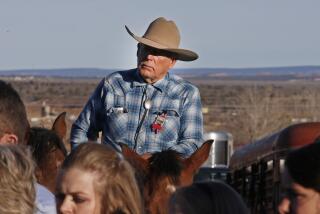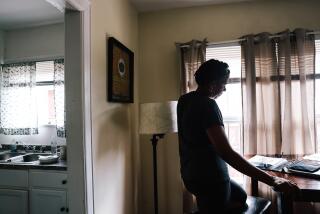Archives of Hunt for Serial Killer Ted Bundy Pose Delicate Issues
- Share via
SEATTLE — Much of the story of the search for one of the nation’s most notorious serial killers can be found in 19 cardboard boxes stored in a warehouse at the King County Archives and Records Center here.
Witness reports. Police logs. Suspect files. Tip sheets. Audiotaped interviews. Detectives’ notes. Computer lists of Volkswagen owners. Crime-scene and autopsy photographs of young women brutally raped and strangled.
These are the county police investigative files on Theodore Bundy, the former law school student turned cross-country murderer whose killing spree during the 1970s struck terror first in Washington state and Oregon--and later in Colorado, Utah and Florida.
They tell the story of a handsome stranger named “Ted” who sweet-talked some of his victims into his 1968 Volkswagen Beetle by wearing a phony cast and asking for their help--then handcuffing them, bludgeoning or strangling them and dumping their bodies on remote hillsides.
But who gets to see the files, and how much of the material is made available, are questions archives workers and county prosecutors are still sorting out.
Bundy confessed to killing 23 women in Washington, Oregon, Utah, Colorado and Florida before he was executed in 1989 for the kidnap-slaying of a 12-year-old Florida girl.
Authorities suspected him of dozens more killings, some committed after his escape from a Colorado jail in 1977.
The boxes, some simply marked “Ted Files”--the killer’s first name was known long before authorities zeroed in on Bundy--rest on shelves alongside such mundane county historical records as land appraisals, rezoning maps, highway plats, jury lists and financial invoices.
King County officials decided to archive the files--meaning they will be specially preserved, made accessible to the public and never destroyed--because of the notoriety of the Bundy case and because the materials offer a glimpse of criminal investigative techniques that were being used for the first time.
“Certainly, anything that’s notorious has historical value,” said Nancy Craver, head of the county’s archives and records-management program.
“If these files were stored permanently without archival preservation, some of the media--for example, magnetic audiotapes, color photographs and maps on fragile, acidic paper--would deteriorate relatively quickly, and the information on the media would be lost forever,” she said.
Archivists plan to transcribe the audiotapes and rewind them at the correct tension; encapsulate and, where necessary, make new prints of photos; and reproduce or deacidify the maps.
The records will be processed--arranged, described, indexed and made computer-searchable--and then moved to the archive center’s temperature- and humidity-controlled vault.
The archive center and attorneys in the county prosecutor’s office are mulling over ground rules for access.
The situation is unusual because the Bundy materials are the only collection the center has that contain criminal-investigation files with restricted information, Craver said.
The county Department of Public Safety gave the files to the archives center in 1993 on condition that no information be released on people who were investigated besides Bundy, people involved in any crime that did not result in a conviction, and any identifying information on juveniles and their parents.
Shortly after the Bundy files arrived, the archives center got its first request for access from the A&E; cable channel in 1993, for a television documentary on serial killers.
That request was straightforward and easily dealt with. A&E; wanted representative sketches and pictures--the type you might find in a high school or college yearbook--of the victims.
But a dilemma arose late last year when two students taking a University of Washington criminology class sought access to the entire Bundy file. The class was taught by Robert Keppel, a former King County detective who investigated several Seattle-area “Ted” slayings.
To fulfill the request, archives workers would have had to manually go through every item in the 19 boxes--line by line, photo by photo--to black out or withhold any information exempt from public-disclosure laws.
With only two full-time archivists, Craver says her agency didn’t have the staff to make such a time-consuming task a high priority.
Moreover, no one in the office was eager to tackle the job because of the nature of the files.
“There are some pretty gruesome pictures and they’re mixed in,” said assistant archivist Brian Lencho, who examined some of the materials in responding to A&E;’s request.
“I’m not very susceptible to nightmares. I’ve watched horror movies. It doesn’t follow me around. But these images are very graphic,” Lencho said.
“When you see child pictures of little girls and then you see sketches of Ted, and then you see the parts of their decomposing bodies where the searchers found them, and then you hear Ted’s description of what he did. . . . It’s more graphic because it’s not designed to be a novel.
“It’s scary because it’s so real.”
Keppel’s students never did get permission to review the entire Bundy file. Their course ended before the archive center worked out a policy for public-access requests.
The archive center is now consulting with the county prosecutor’s office to work out such a policy.
“We don’t want to let high school kids come in and do research on these,” Craver said. “Those are some of the things we’re trying to figure out.”
Keppel, the former “Ted” investigator who is now an assistant state attorney general, says the files won’t hold any secrets once all the extraneous names and faces have been erased.
The Bundy case already has been the subject of several books, including those written by Keppel, Ann Rule, Richard Larsen and co-authors Stephen Michaud and Hugh Ainsworth.
“Once you cull out all of the names of the people who were investigated, names of people who were contacted, suspects, witnesses and things . . . there’s not much left that’s not already out there,” Keppel said.
That’s not to say some people won’t want a firsthand look at all the original materials.
The Bundy files “represent an investigation into one of the more notorious murder trials of the century,” Craver said.
She gets no argument from David Yocom, a Utah assistant attorney general who investigated suspected Bundy murders in that state as a Salt Lake County deputy attorney.
“It’s a hell of a mystery and it’s a hell of a crime-solving story,” Yocom said.
More to Read
Sign up for Essential California
The most important California stories and recommendations in your inbox every morning.
You may occasionally receive promotional content from the Los Angeles Times.










